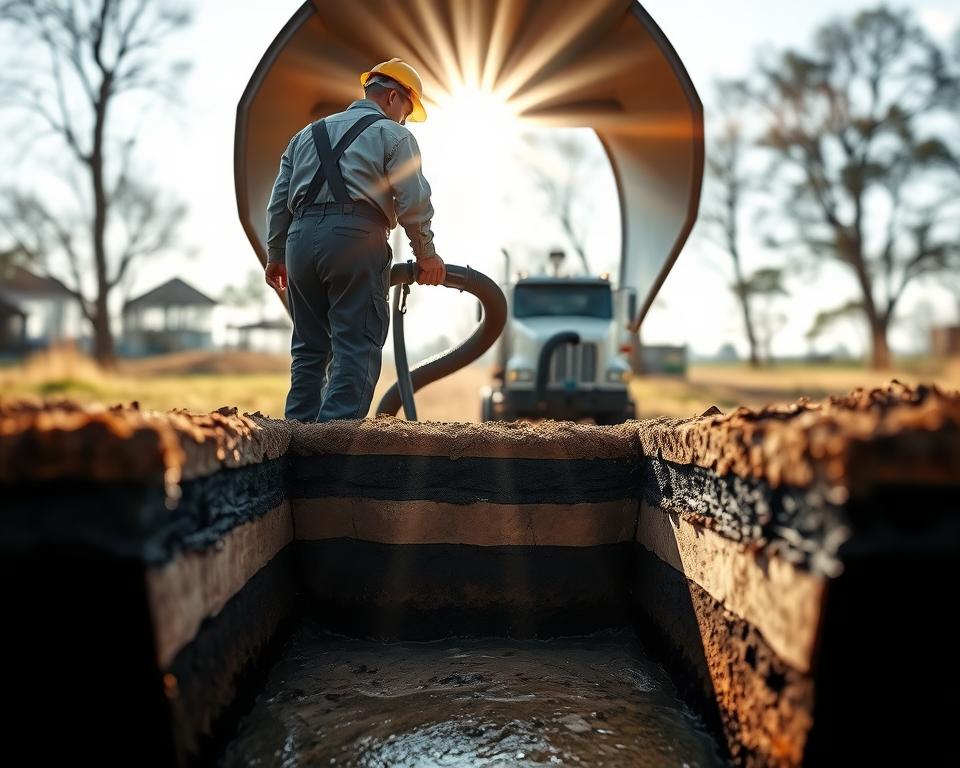Septic Aerator Pump: Essential Guide for Homeowners
Curious about what enhances your aerobic Septic setup’s effectiveness? The Septic tank aerator is the unrecognized champion integral for your system. Throughout this overview, homeowners will get useful knowledge on the aerator’s function. It’s essential for a healthy, efficient Septic system.
Appreciating the necessity of a Septic tank air Pump can boost your Septic system’s capabilities using septic pumping cost. It also protects your property’s value and local environment. The following guide will introduce All in Sanitation, a trusted Septic industry expert. They’re equipped to handle your Septic aerator Pump requests.
Primary Points
- The Septic air Pump is vital for air-driven Septic tanks.
- Properly caring for your Septic system air Pump can optimize overall system efficiency.
- Periodic reviews lengthen the service life of your Septic tank air Pump.
- Opting for the correct Septic aerator Pump is essential for maximum operation.
- All in Sanitation provides specialized services for Septic air Pump needs.
Understanding Aerobic Septic Solutions
Aerobic Septic systems offer a superior waste treatment method by utilizing oxygen. This process relies on aerobic bacteria operating in well-oxygenated environments. These bacteria are highly effective in digesting organic matter. With the help of Septic aerator Pumps, these systems ensure a consistent oxygen supply, accelerating the waste decomposition process.
These systems perform well in reducing sludge buildup, thanks to the hard work of aerobic bacteria. This drop in solid waste means less maintenance and tank emptying is necessary. Additionally, they reliably process wastewater, resulting in reduced odors. This ensures a healthier environment for homeowners and the community overall.
To ensure these systems function properly, it’s essential to understand the key Septic system components. These include the Septic tank, treatment chamber, and effluent Pump. Each component has a crucial role, especially the air Pump. It pushes oxygen into the tank, crucial for the aerobic bacteria’s performance.
Role of the Septic Air Pump
The Septic air Pump is key in the functioning of aerobic Septic systems. It acts as the system’s “oxygen source,” providing the vital oxygen mandatory. This oxygen helps aerobic bacteria to flourish and digest waste properly. If the Pump stops, the system’s capability drops, leading to sludge increase and possible odors.
Such issues can undermine Septic system operations and lead to environmental hazards. By acknowledging how important the Septic air Pump is, homeowners can act preemptively. They can keep its optimal function through consistent upkeep. This avoids failures, reduces costly repairs, and preserves the aerobic system’s health.
Key Benefits of Using a Septic Air Pump
Employing a Septic air Pump notably enhances the performance of Septic systems. Septic air Pumps are vital as they fast-track the decomposition of waste. This is accomplished by oxygenating the treatment process, stimulating aerobic bacteria growth. These bacteria are essential for effective waste treatment.
They’re also instrumental in reducing foul smells. Because of more active aerobic processes, waste decomposes faster, thus reducing odors. This creates a nicer atmosphere for homeowners.
Another noteworthy benefit is the drop in sludge buildup. Consequently, tanks need less frequent Pumping, conserving both money and time. Better processing not only reduces spending but also extends the lifespan of the drain field.
Looking after these Pumps diligently means fewer repair costs and meeting regulatory standards. Thus, the benefits of Septic air Pumps go beyond being for homeowners. They also contribute to environmental health by advancing waste management practices.
| Benefit | Description |
|---|---|
| Fast Waste Breakdown | Increased aerobic activity speeds the decomposition process. |
| Minimized Odor Emissions | Improved treatment efficacy leads to fewer odors. |
| Reduced Sludge Buildup | Reduced Pumping and maintenance are required. |
| Extended Drain Field Life | Better treatment ensures a healthier drain field. |
| Cost Savings | Lower probability of repairs and regulatory compliance cost. |

Choosing the Right Septic Air Pump
Opting for the correct Septic air Pump is key for an optimized aerobic system. Homeowners must consider various factors for the ideal match. The capacity of the tank and the airflow requirements matter greatly the Pump’s performance.
To decide wisely, it’s helpful to know the air Pumps available. There are mainly two types: linear diaphragm Pumps and rotary vane Pumps. Each comes with specific strengths, which should be matched with your home’s particular demands and how it operates.
Power consumption also deserves attention. Choosing a Pump that lowers energy use while achieving the needed airflow can lead to significant savings. Support from All in Sanitation specialists can be extremely useful. They make certain the Pump you choose fits your system’s requirements precisely.
Major Kinds of Septic Air Pumps
Homeowners can select wisely by being aware of the distinct Septic air Pumps available. There are mainly two types: diaphragm Pumps and rotary vane Pumps. Each has its particular functions and benefits.
Diaphragm Pumps, known for their hushed operation, are favored for residential Septic systems. They provide energy efficiency while supplying consistent airflow. Their reliable performance fits smaller systems, appealing to many homeowners.
Rotary vane Pumps, however, are ideal for larger or commercial systems. These Pumps deliver higher capacity, necessary for handling bigger loads. Their durable build guarantees efficient operation in extensive Septic systems.
| Type of Pump | Best Use | Advantages |
|---|---|---|
| Diaphragm Pumps | Residential Systems | Quiet operation, energy-efficient, reliable air flow |
| Rotary Vane Pumps | Larger or Commercial Systems | Powerful performance, high capacity, durable construction |
Understanding the variations in Septic air Pumps is essential for upgrades or replacements. Each Pump type brings unique qualities to meet various needs. This secures best performance for any system.
How to Tell You Need a Septic Air Pump Replacement
Homeowners must monitor Pump failure signs in their Septic systems. Some indicators point towards the need for a Septic air Pump replacement. These support reliable function. Spotting these early prevents serious issues.
Signs of potential problems include:
- Unusual noises from the Pump, like scraping or vibrating, might suggest internal damage.
- A clear lack of air output suggests the Pump isn’t operating efficiently, affecting efficiency.
- Frequent electrical problems, such as tripped breakers or lights dimming, could point to overloading.
- Visible damage on the Pump unit, with cracks or leaks, calls for quick action.
- Bad smells in the yard often suggest a compromised Pump, meaning ineffective effluent aeration.
Finding these signs early avoids pricey restoration or total system failure. Conducting routine inspections helps identify these issues. It also confirms if you ought to have a new Septic air Pump.
Upkeep Advice for Your Septic Air Pump
For an efficient Septic air Pump, regular maintenance is crucial. This ensures that your system operates correctly. Homeowners can apply several practical care strategies for optimal results.
Bi-annually, run a comprehensive inspection for wear or damage. It is also important to change the filters as advised. This prevents clogs that could hamper efficiency.
The Pump should rest on a stable base to cut vibrations, which could wear it over time. A protective cover is vital too. It guards against debris and water, keeping the Pump’s functionality.
Proper maintenance can greatly prolong the life of your Pump. In turn, this enhances the Septic system’s performance as a whole.
| Maintenance Task | Frequency | Benefits |
|---|---|---|
| Inspect Pump for damage | Every 6 months | Catches problems quickly |
| Replace filters | As needed | Improves efficiency |
| Check surface stability | Annually | Minimizes shake |
| Clear debris around Pump | Monthly | Stops blockages |
Installing Your Septic Air Pump
Effective installation of your Septic air Pump is vital for its reliable operation. First, pick a safe, moisture-free area for placement. The chosen spot should firmly accommodate the Pump’s weight without issue.
To reliably install your Pump on your own, follow the following guidelines:
- Assemble all necessary items, including the Pump, a power source, and hose fittings.
- Carefully read the manufacturer’s guidelines before starting your installation.
- Verify every connection is secure to eliminate air leaks that compromise performance.
- After assembly, conduct a test to verify the system works as intended.
If the installation process feels tricky, call All in Sanitation. Their professionals can sidestep common errors, ensuring your setup meets relevant safety requirements.
Benefits of Choosing All in Sanitation for Your Septic Air Pump Solutions
When deciding on a Septic service provider, the choice is significant. All in Sanitation differentiates itself by delivering dependable Septic air Pumps. They address different homeowner requirements with a extensive selection of quality products. This means customers secure an perfect match for their Septic systems.
What clearly distinguishes All in Sanitation is more than their broad product lineup. Their devotion to outstanding customer service is just as important. Homeowners enjoy professional guidance, steering them toward trusted Septic solutions. This teamwork is crucial to personalize each solution to fulfil specific needs.
All in Sanitation also emphasizes aftercare to guarantee lasting satisfaction. Their devotion continues beyond the initial sale. They provide ongoing support to maintain Septic systems functioning optimally for the long term.
Expense Overview for Septic Air Pumps
Appreciating the financial elements tied to Septic air Pumps is vital for homeowners with aerobic Septic systems. At first, one faces the initial cost, which includes the Pump and associated accessories. Installation expenses differ, based on the system’s complexity and any adjustments required.
Ongoing upkeep forms an additional cost layer. Routine checks can fend off bigger issues, eventually resulting in savings. Homeowners should budget for Septic maintenance to preserve the Pump’s effectiveness and longevity. Such planning sidesteps expensive repairs later on, highlighting the importance of proactive maintenance.
| Cost Component | Average Cost Range |
|---|---|
| Septic Air Pump | $500 – $1,200 |
| Installation | $300 – $800 |
| Annual Maintenance | $150 – $400 |
| Potential Repair Costs | $1,000 – $5,000 |
Itemizing Septic air Pump expenses into individual parts assists homeowners in cost forecasting. This thorough approach secures the system’s reliable running and their reassurance.
The Final Word
For homeowners with aerobic Septic systems, looking after Septic units is crucial. The right Septic air Pump improves waste processing and prolongs your system’s life. Practising ongoing care and immediately resolving issues avoids large repair bills and disruptions.
Opting for a Septic air Pump requires careful thought. This guide highlighted how to choose wisely about installation and replacement. With All in Sanitation’s support, you can handle your Septic systems’ complexities with confidence.
Maintaining your Septic air Pump promotes your system’s performance and durability. It guarantees a efficient and proper operation over time. Bear in mind, your home’s wastewater management relies heavily on ongoing maintenance.

